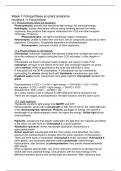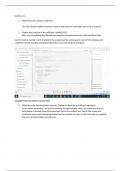Week 1 Fotosynthese en plant anatomie
Hoofdstuk 11 Fotosynthese
11.1 Photosynthesis feeds the biosphere
Photosynthesis: process that transforms light energy into chemical energy.
Autotrophs: sustain themselves without eating anything derived from other
organisms, they produce their organic molecules from CO2 and other inorganic
molecules. Producers.
Photoautotrophs: use light to synthesise organic molecules.
Heterotrophs: unable to make their own food, live on compounds produced by other
organisms. Consumers. Completely dependent on photoautotrophs.
Decomposers: consume remains of other organisms.
11.2 Photosynthesis in chloroplasts
Chloroplast: eukaryotic organelle that absorbs energy from sunlight and uses it to
drive the synthesis of organic molecules from CO2 and water. In this chapter in
plants.
Chloroplasts are found in all green parts of plants, but mainly in cells of the
mesophyll: cell layer in the interior of the leaf. Gas exchange happens via pores
called stomata. Water is absorbed by the roots and delivered in veins.
A mesophyll cell has 30-40 chloroplasts. A chloroplasts has two membranes
surrounding the stroma (dense fluid) with thylakoids (membranous sacs with
thylakoid space inside, membranes have green pigment chlorophyll) stacked into
grana.
Photosynthesis: 6 CO2 + 12 H2O + light energy → C6H12O6 + 6 O2 + 6 H20
Net equation: 6 CO2 + 6H2O + light energy → C6H12 + 6 O2
Simplest form: CO2 + H2O → [CH2O] + O2
As a redox reaction CO2 is reduced to C6H12O6 and H2O is oxidised to O2.
There are two stages of photosynthesis: the light reactions and the calvin cycle.
11.3 Light reactions
Thylakoids transform light energy into NADPH and ATP.
Electromagnetic waves with a wavelength of 380-740 nm fall on the visible light part
of the electromagnetic spectrum. Photons: packages of energy, the shorter a
wavelength of an electromagnetic wave, the higher the energy. Visible light drives
photosynthesis.
Pigments: substances that absorb visible light, the light they don’t absorb and reflect
is the colour we see them as. Chlorophyll is a green pigment.
Absorption spectrum: shows wavelength absorption measured by a
spectrophotometer.
Action spectrum: wavelengths that are most useful, most absorbed, the action
spectrum for photosynthesis is broader than the action spectrum of chlorophyll a.
There are three types of chlorophyll: chlorophyll a (most important), chlorophyll b
(olive green), and accessory pigments called carotenoids: yellow/orange
hydrocarbons, also functions as photoprotection: they absorb excessive/harmful
light energy.
When a pigment absorbs light, one of the molecule's electrons is elevated into an
orbital with more potential energy. Only photons with the exact energy of the
difference between ground and excited state are absorbed. After, electrons drop
,back down to their ground state, releasing energy as heat (sometimes as photons =
fluorescence).
Photosystem: reaction-centre complex surrounded by light-harvesting complexes.
Light-harvesting complex: pigment molecules bound to proteins, acts as antenna.
When a pigment absorbs a photon, the energy is passed from pigment to pigment
until it gets to the pair of chlorophyll a molecules in the reaction-centre complex
(protein) Here an excited electron is passed from the chlorophyll a pair to the
primary electron acceptor.
There are two photosystems, in order:
Photosystem II, chlorophyll a pigment P680
Photosystem I, chlorophyll a pigment P700.
Linear electron flow: route of electron flow during the light reactions that produces
ATP, NADPH and O2 from H2O and NADP+:
1. Photon excites a pigment electron in a light-harvesting complex of PSII,
energy goes from pigment to pigment until it reaches the P680 pair and
excites an electron.
2. The excited electron is transferred to the primary electron acceptor → P680+.
3. An enzyme splits H2O into two electrons (both going to P680), two protons
(going to the thylakoid space, and an oxygen (combines with another O to
form O2).
4. The photoexcited electron is passed down an ETC from PSII to PSI made up
of the electron carrier plastoquinone Pq, a cytochrome complex, and a protein
plastocyanin, free energy released pumps protons into the thylakoid space.
5. Potential energy stored in proton gradient is used to synthesise ATP.
6. Light energy from light-harvesting complex of PSI excites P700 molecules, the
photoexcited electron is transferred to PSI’s primary acceptor. The new P700+
acts as the acceptor at the end of the ETC.
7. Electron goes down a second ETC, through Ferredoxin Fd.
8. NADP+ takes two electrons at a time from Fd, becoming NADPH, which goes
to the calvin cycle.
Cyclic electron flow only uses PSI: the electrons cycle from Fd to the cytochrome
complex, then via Pc back to P700. This generates ATP, but no NADPH or O2.
11.4 The calvin cycle
The calvin cycle uses ATP and NADPH to form glyceraldehyde-3-phosphate from
CO2, for every calvin cycle, one C is fixed in the 3C G3P. There are three phases in
one cycle:
1. Carbon fixation: rubisco adds CO2 to ribulose bisphosphate RuBP C5 → C6,
which quickly splits into two 3C 3-phosphoglycerates.
2. Reduction: Each molecule is phosphorylated by ATP → 1,3-
bisphosphoglycerate, reduced by NADPH and loses P group → G3P.
3. Regeneration of RuBP: six G3P’s are rearranged into 1 G3P and 3 RuBP by
spending three more ATP. [Net input: 9 ATP, 6 NADPH, 6 CO2 // net output: 1
G3P]
11.5 Alternative carbon fixation
Photorespiration: a metabolic pathway that consumes O2 and ATP, releases CO2,
and decreases photosynthetic output. Generally occurs more on hot, dry, and bright
days with closed stomata.
,Hoofdstuk 35 Plant structuur en groei
35.1 Plants consist of organs, tissues, and cells
Tissues are groups of cells that perform a specialised function. Organs are several
types of tissues that carry out particular functions together.
Roots form the root system and stems and leaves the shoot system. Roots are not
photosynthetic and starve unless photosynthates, sugars, are imported from the
shoot system. On the other hand the shoot system depends on water and minerals
roots absorb.
Roots anchor vascular plants and absorb water and minerals, and often store
carbohydrates. The primary root from the germinating seed embryo branches to
form lateral roots.
Tall plants with large shoots have a taproot system with a vertical taproot, which
develops from the primary root, for anchorage and food storage.
Small vascular plants have a fibrous root system: a mat of slender roots. In these
plants, mostly monocots, the primary root dies and instead many small roots emerge
from the stem, these roots are adventitious: plant organs that grow in unusual
locations.
Water and mineral absorption occurs at the tips of roots where a lot of root hairs:
thin extensions of root epidermal cells, are located.
Stems bear leaves and buds, elongate and orient the shoot in a way that maximises
photosynthesis and elevates reproductive structures. Each stem consists of nodes,
at which leaves are attached, and internodes, stem segments between nodes. Most
shoot growth happens at the tip, or apical bud. Axillary buds appear in the upper
angle, axil, between a leaf and stem and have the potential to form a lateral shoot,
branch, or flower.
Modified stems often mistaken for roots: rhizomes, stolons, and tubers.
Leaves are the main photosynthetic organ, exchange gases, dissipate heat, and
defend themselves from herbivores and pathogens. They consist of a flattened blade
and a petiole (stalk), which joins the leaf to the stem at a node. Monocots and
eudicots differ in arrangement of veins: vascular leaf tissue. Monocots have parallel
equal veins, eudicots have a branched network arising from the major vein that runs
down the centre. In a compound leaf the blade consists of multiple leaflets, a leaflet
has no axillary bud at its base. Some evolutionary adaptations of leaves are tendrils,
spines, storage, and reproduction.
—- Week 2, daar herhaald -----------------------------------------------------------------------------
Roots, stems, and leaves are composed of dermal, vascular, and ground tissue,
together forming a tissue system.
The dermal tissue serves as a protective covering, in nonwoody plants it is a single
layer called the epidermis which is covered by the cuticle. In woody plants tissues
called the periderm replace the epidermis in stems and roots. The epidermis
absorbs water in roots and has guard cells for gas exchange and trichomes (hairlike
outgrowth) for reduced water loss and defence in shoots.
The vascular tissue facilitates transport and provides mechanical support. Xylem
conducts water and minerals upwards and phloem transports sugars from where
they are made to where they are stored. The vascular tissue of a root or stem is
, called the stele, which can be a vascular cylinder in roots of angiosperms and
vascular bundles in stems and leaves.
The ground tissue is the rest, internal to the vascular tissue known as pith, external,
known as cortex. It includes cells for storage, photosynthesis, support, and short-
distance transport.
Plants cells undergo differentiation and become specialised:
Parenchyma: have thin and flexible primary walls, no secondary walls and a
large vacuole. They perform most of the metabolic functions.
Collenchyma: grouped in strands, with unevenly thickened cell walls. They
provide support without restraining growth in stems.
Sclerenchyma: secondary wall contains lignin, mature cells cannot elongate.
Sclereids are boxier and more irregular than fibres. They support woody
plants.
Xylem, tracheids: tubes, dead, and lignified at maturity, vessel elements:
thick walls after they die remain to form a nonliving water conduit. Water can
migrate between neighbouring cells through pits: thinner regions with only a
primary wall.
Phloem, sieve tube elements: form the sieve tube in angiosperms, they lack
a nucleus, vacuole, and cytoskeleton. Sieve plates: walls between sieve-tube
elements facilitate fluid flow. Each sieve-tube element has a companion cell,
which doesn’t conduct, but has a nucleus and ribosomes to serve both cells.
—--------------------------------------------------------------------------------------------------------------
Aanvullende informatie fotosynthese
Chlorophyll in chloroplasts converts light energy to ATP and NADPH in the light
reaction. In the dark reaction Rubisco couples CO2 to RuBP. Three dark reactions
generate G3P at the expense of ATP and NADPH. After G3P is generated it is
reconverted to RuBP at the cost of 1 ATP or transported out of the chloroplast and
converted to glucose.
By placing leaves in gas-tight cuvettes net CO2 uptake can be measured. Net uptake
consists of absorption by carbon fixation and production by respiration. The
photosynthetic rate is expressed as umol carbon fixed per m2 leaf area per
second.
The three factors that determine photosynthetic rate are light, CO2, and rubisco.
CO2 response curve: if CO2 is the limiting factor, the rate of reaction follows the
activity of rubisco and how often it regenerates RuBP. The amount of CO2 necessary
to get an equal rate of consumption and production is called the CO2 compensation
point CCP.
Light response curve: if light is the limiting factor, there isn’t enough energy to
regenerate RuBP. At the light compensation point LCP consumption and
absorption of CO2 are equal. The slope at the light compensation point is the
quantum yield: how many additional moles of CO2 can be fixed with a given number
of added photons. Once the light intensity increases beyond the LCP, the slope of
the line will decrease until light saturation.
Photorespiration occurs when instead of CO2, O2 is bound to RuBP by rubisco. In
this oxygenation reaction a C3 and C2 are formed. C2 can’t be used to produce






